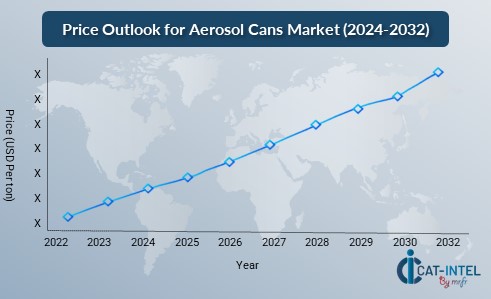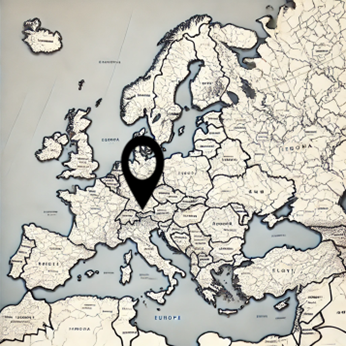Aluminium Aerosol Can Price Drivers Market Overview:
The pricing dynamics of aluminium aerosol cans are influenced by multiple market drivers, including raw material costs, technological advancements in manufacturing, and the demand from industries such as personal care, healthcare, and food & beverage. A surge in raw aluminium prices, driven by fluctuations in supply and demand as well as geopolitical factors, is a primary driver impacting production costs. Furthermore, the adoption of more sustainable and lightweight designs is pushing companies to invest in innovative production methods, potentially increasing upfront costs but improving long-term efficiency. Additionally, consumer preference for recyclable packaging and increasing environmental regulations are shaping pricing by encouraging eco-friendly manufacturing practices and materials. This report delves into these price drivers, analysing the influence of raw materials, environmental policies, and technology advancements, while highlighting trends in procurement strategies that can mitigate price volatility.
The market outlook for aluminium aerosol cans is strong, with several key trends indicating steady growth through 2032:
- Market Size: The global aluminium market is expected to reach approximately 65.6 billion by 2032, driven by a compound annual growth rate (CAGR) of around 4.40% from 2024 to 2032.
Growth Rate:4.40%
- Sector Contributions: Growth are driven by:
-
- Personal Care and Cosmetics: Rising demand for sustainable and user-friendly packaging in products like deodorants and hair sprays is a major driver.
- Pharmaceuticals and Healthcare: Growth in demand for sterile and durable packaging solutions boosts demand in this sector.
- Sustainability Initiatives: Companies are investing in sustainable production methods, such as recycled aluminium content and eco-friendly coatings, to meet consumer preferences and regulatory standards for environmental impact reduction.
- Regional Insights: Europe and North America lead in the adoption of sustainable practices.
Key Trends and Sustainability Outlook:
- Sustainability Focus: Increasing emphasis on eco-friendly packaging solutions is driving demand for recyclable aluminium cans.
- Technological Advancements: Innovations in can design and manufacturing enhance customization and functionality, attracting more brands.
- Consumer Preferences: Growing demand for convenient and portable packaging in sectors like personal care and food is bolstering the market.
- Regulatory Changes: Stricter environmental regulations are prompting manufacturers to adopt sustainable practices, influencing pricing strategies.
Growth Drivers:
- Rising Demand in Personal Care: Expanding usage of aluminium aerosol cans in cosmetics and personal care products is a major growth factor.
- Automotive and Industrial Applications: Increased use of aluminium cans in automotive lubricants and industrial products contributes to market growth.
- Global Urbanization: Growing urban populations are boosting consumer demand for convenient packaging solutions.
- Investment in Recycling Technologies: Advances in recycling processes are enhancing the sustainability profile of aluminium aerosol cans, attracting eco-conscious consumers.
- Market Competition: Heightened competition among manufacturers encourages innovation and efficiency, impacting pricing dynamics.
Overview of Market Intelligence Services for the Aluminium Aerosol Can Price Drivers Market
Recent analyses highlight that the aluminium market faces challenges due to fluctuating raw material costs, energy expenses, and environmental regulations. Market reports provide detailed cost projections and insights into procurement strategies, helping companies manage price variations while ensuring sustainable operations. By leveraging these insights, stakeholders can adopt cost-saving measures, optimize supply chains, and maintain efficiency in a competitive and evolving market.
Procurement Intelligence for Aluminium Aerosol Can Price Drivers: Category Management and Strategic Sourcing
To remain competitive in the aluminium aerosol can market, businesses are optimizing procurement strategies using cost tracking tools to monitor supplier expenses and enhance supply chain performance with market intelligence. Strategic sourcing and effective category management are crucial for cost-efficient procurement and ensuring a consistent supply of aluminium aerosol cans.

Pricing Outlook for Aluminium Aerosol Price Drivers: Spend Analysis
The pricing for aluminium aerosol cans is anticipated to experience moderate fluctuations due to various market dynamics. Factors such as rising raw material costs, particularly for aluminium, and increasing demand for sustainable packaging are expected to exert upward pressure on prices. Additionally, operational costs linked to production and logistics are likely to impact overall pricing strategies.
Graph shows general upward trend pricing for aluminium aerosol price drivers and growing demand. However, there may be fluctuations influenced by economic conditions, technological advancements, and competitive dynamic.

The aluminium aerosol can market is forecasted to see gradual growth in pricing over the coming years, driven by increased demand across personal care, household, and pharmaceutical sectors. Supply chain disruptions and fluctuations in production costs will contribute to pricing challenges. However, advancements in recycling technologies and greater use of recycled materials can help stabilize costs.
Manufacturers are focusing on optimizing their supply chains and forging strategic partnerships to manage expenses effectively, ensuring competitive pricing while meeting consumer demands for eco-friendly solutions.
Cost Breakdown for the Aluminium Aerosol Can Price DriversTotal Cost of Ownership (TCO) and Cost Saving Opportunities:
- Research Materials (40%)
- Description: This category encompasses the costs associated with sourcing primary aluminium, bauxite, and other essential materials required for aluminium aerosol can production.
- Trends: There has been a marked increase in the prices of raw materials due to supply chain disruptions and geopolitical factors, prompting manufacturers to seek more strategic procurement agreements to ensure stable pricing.
- Labor (XX)
- Description: XX
- Trends: XX
- Publishing Services (XX%)
- Description: XX
- Trends: XX
- Infrastructure & Overheads (XX%)
- Description: XX
- Trends: XX
Cost Saving Opportunities: Negotiation Lever and Purchasing Negotiation Strategies
In the aluminium aerosol can market, optimizing procurement strategies can lead to significant cost savings and improve operational efficiency. Collaborative partnerships among manufacturers can facilitate shared resources and pooled purchasing power, effectively lowering individual costs. The adoption of innovative manufacturing technologies can enhance production efficiency while reducing material waste. Implementing sustainable practices in the supply chain can minimize raw material costs and attract environmentally conscious consumers. Furthermore, leveraging digital tools for inventory management helps streamline operations and reduce excess stock.
Strategic sourcing of raw materials and exploring alternative suppliers can mitigate price volatility, while energy-efficient production methods can lower utility expenses. Overall, these procurement strategies empower aluminium aerosol can manufacturers to enhance their market competitiveness while effectively managing costs.

Supply and Demand Overview for Aluminium Aerosol Can Price Drivers: Demand-Supply Dynamics and Buyer Intelligence for Effective Supplier Relationship Management (SRM)
The aluminium aerosol can market is witnessing strong growth due to rising demand in personal care, pharmaceuticals, and household product sectors. This demand is further fueled by advancements in manufacturing technologies and increasing consumer preference for sustainable and recyclable packaging solutions.
Demand Factors:
- Rising Consumer Demand: The increasing popularity of aluminum aerosol products in personal care and household markets is driving higher demand.
- Sustainability Trends: A growing preference for environmentally friendly packaging is boosting the demand for aluminium aerosols due to their recyclability.
- Innovations in Product Formulation: The introduction of new and improved formulations requiring aerosol delivery systems is contributing to increased demand.
- Expansion in End-Use Industries: Growth in industries such as cosmetics, pharmaceuticals, and food and beverage is further fuelling the demand for aluminium aerosol packaging.
Supply Factors:
- Raw Material Availability: Fluctuations in the availability of bauxite and alumina can impact the production costs and supply of aluminium.
- Production Capacity: The ability of manufacturers to scale production efficiently affects the overall supply of aluminium aerosols in the market.
- Technological Advancements: Innovations in manufacturing processes can enhance production efficiency, affecting the supply dynamics of aluminium aerosols.
- Regulatory Environment: Changes in regulations regarding the use of aerosol products can influence supply levels and market pricing.
Regional Demand-Supply Outlook: Aluminium Aerosol Price Drivers:
The Image shows growing demand for Aluminium Aerosol Can Price Drivers in both Europe and Asia, with potential price increases and increased Competition.
Europe: Dominance in Aluminium Aerosol Price Drivers.
Europe, particularly countries like Germany, France is witnessing a significant growth trajectory in the aluminium aerosol market characterized by:
- High Consumer Demand: The increasing popularity of personal care and household products packaged in aluminium aerosols is driving strong consumer demand across the region.
- Sustainability Initiatives: European countries are placing a high emphasis on sustainability, leading to a growing preference for recyclable packaging solutions like aluminium aerosols, which are perceived as environmentally friendly.
- Established Manufacturing Base: Europe has a well-developed manufacturing infrastructure, enabling efficient production and distribution of aluminium aerosol products to meet rising market demands.
- Regulatory Support: Government regulations promoting the reduction of single-use plastics and encouraging the use of recyclable materials are fostering growth in the aluminium aerosol sector, enhancing both supply and demand.
- Innovation and Product Development: Continuous innovation in product formulations and delivery systems is expanding the application of aluminium aerosols, catering to diverse consumer needs in various industries, including cosmetics and pharmaceuticals.
Europe Remains a key hub aluminum aerosol can price drivers Innovation and Growth.
Supplier Landscape: Supplier Negotiations and Strategies
The aluminium aerosol can market features a diverse supplier landscape, with both global and regional manufacturers contributing to market dynamics. Suppliers play a critical role in shaping pricing, technological advancements, and product availability. The market remains competitive, driven by established players and emerging firms focusing on sustainable packaging innovations.
Currently, consolidation among leading suppliers is prominent, with major manufacturers holding significant market share. Meanwhile, smaller firms are gaining traction by emphasizing customized solutions and environmentally friendly practices.
Some key suppliers in the aluminium aerosol can market include:
- Aluminium Aerosol Container
- Ball Corporation
- CCL Container
- Crown Holdings
- Ardagh Group
- Exal Corporation
- AptarGroup, Inc.
- Soredia
- Emser
Key Developments Procurement Category Significant Development:
|
Aluminium Aerosol Can Price Drivers Attribute/Metric |
Details |
|
Market Sizing |
Global aluminium market is expected to reach approximately 65.6 billion by 2032, driven by a compound annual growth rate (CAGR) of around 4.40% from 2024 to 2032. |
|
Aluminium Aerosol Can Price Drivers Technology Adoption Rate |
Approximately 50% of manufacturers are adopting advanced production technologies for efficiency and precision. |
|
Top Aluminium Aerosol Can Price Drivers Strategies for 2024 |
Focus on lightweighting, sustainability, cost optimization, and enhanced product designs. |
|
Aluminium Aerosol Can Price Drivers Process Automation |
Nearly 40% of companies have automated manufacturing processes to improve production efficiency. |
|
Aluminium Aerosol Can Price Drivers Process Challenges |
Key challenges include fluctuating raw material prices, energy costs, and sustainability requirements. |
|
Key Suppliers |
Prominent players include Ball Corporation, CCL Container, Crown Holdings, Ardagh Group, and Exalt Corporation. |
|
Key Regions Covered |
North America, Europe, and Asia-Pacific, with key markets in the U.S., China, Germany, and India due to high demand and production capacities. |
|
Market Drivers and Trends |
Growth is driven by increasing demand for personal care and household products, sustainable packaging trends, and innovation in design and functionality. |
Frequently Asked Questions (FAQ):
Our procurement intelligence services provide insights into cost components like raw materials, energy, and logistics, along with supplier performance evaluations and market trends to support cost-effective sourcing.
We evaluate TCO by considering raw material prices, manufacturing costs, transportation, and supplier margins, offering a complete understanding of long-term procurement expenses.
Our risk management solutions focus on mitigating supply chain disruptions, addressing raw material price volatility, and ensuring supplier reliability through data-driven insights.
We provide Supplier Relationship Management (SRM) strategies, emphasizing collaboration, flexible contract terms, and quality assurance for long-term partnerships.
Our recommendations include competitive supplier selection, effective pricing negotiations, and sustainable sourcing practices to ensure efficient procurement.
By leveraging automation and analytics, digital transformation enhances supplier performance tracking, market forecasting, and procurement efficiency.
Supplier performance management ensures adherence to quality standards, timely deliveries, and cost optimization, supporting better decision-making.
Our insights help secure favourable pricing, volume discounts, and flexible payment terms through data-backed negotiation strategies.
We provide market analysis tools that highlight global price trends, cost drivers, and supplier market shares for informed procurement decisions.
We assist in evaluating suppliers' adherence to environmental, safety, and industry standards to maintain compliance.
We offer solutions like diversified sourcing and contingency planning to minimize the impact of supply chain disruptions.
Our tools enable tracking of supplier quality, delivery consistency, and compliance metrics to improve procurement efficiency.
We help identify suppliers implementing sustainable practices, ensuring minimal environmental impact and ethical sourcing.
Our pricing analysis compares supplier costs, identifies negotiation levers, and evaluates market conditions to secure the best value.











